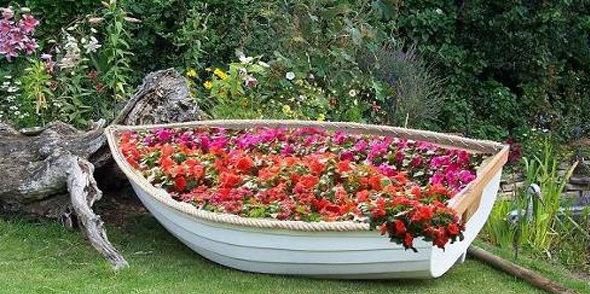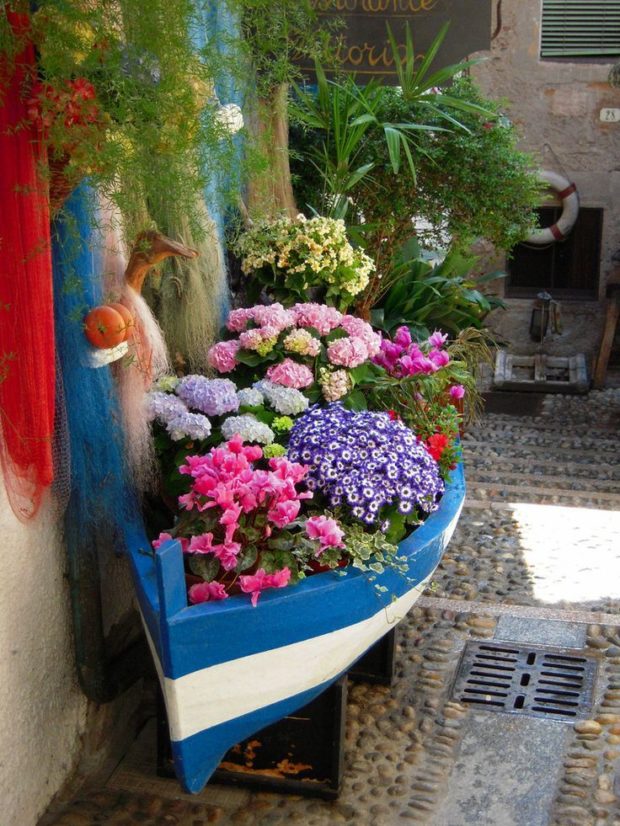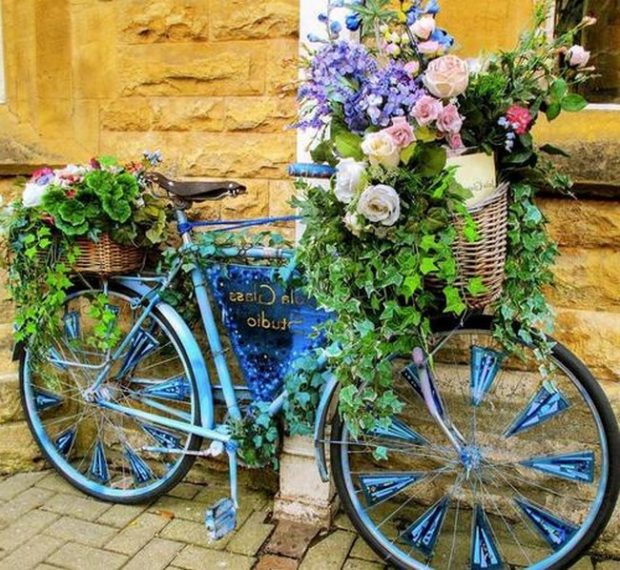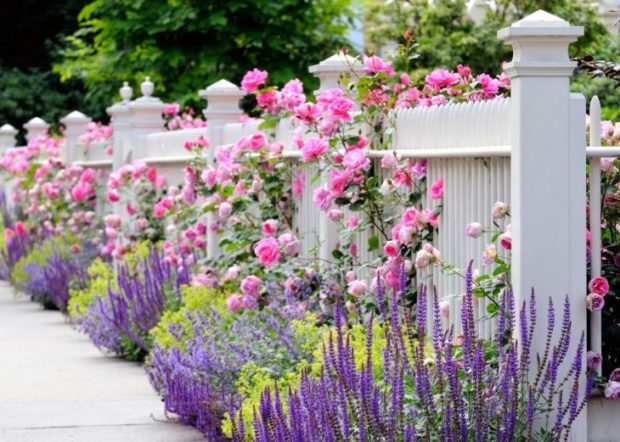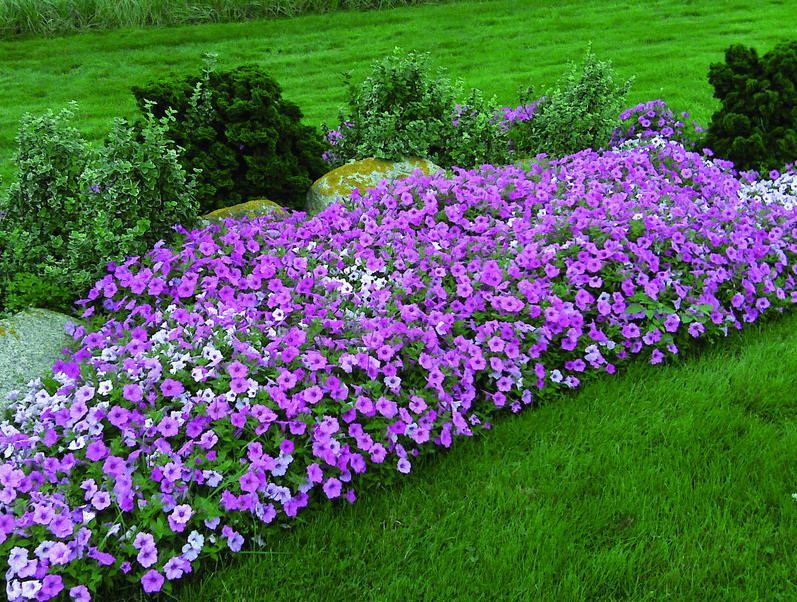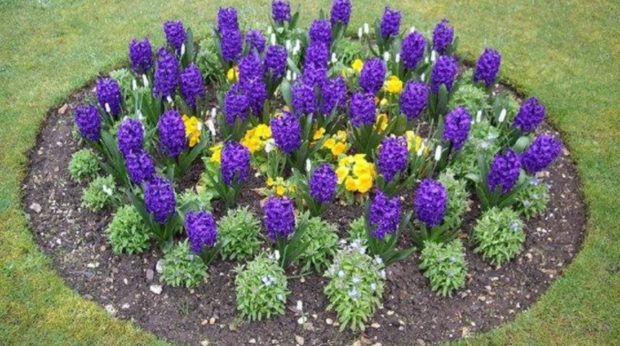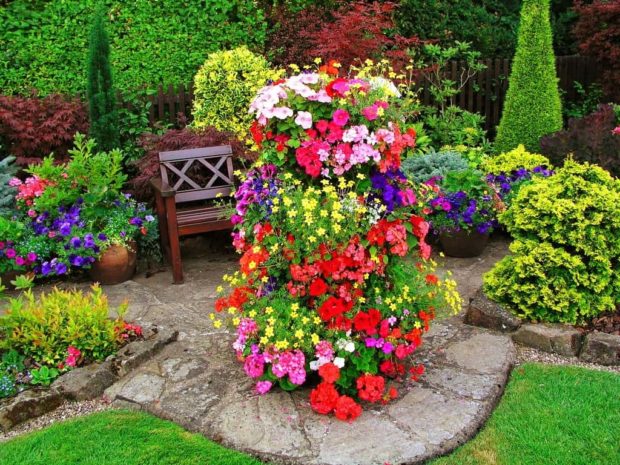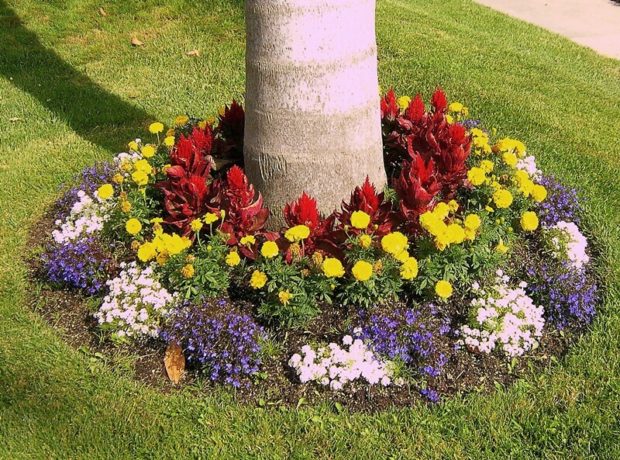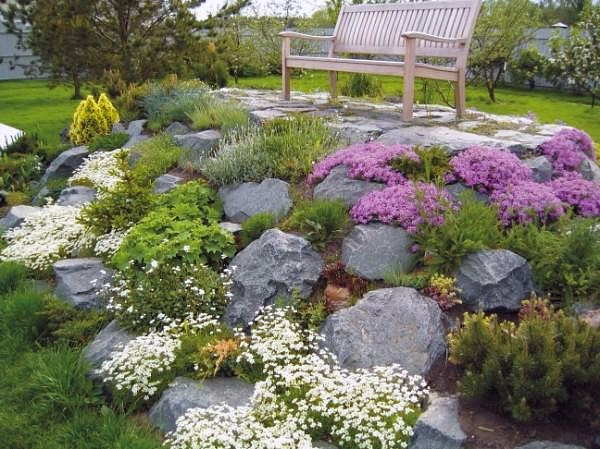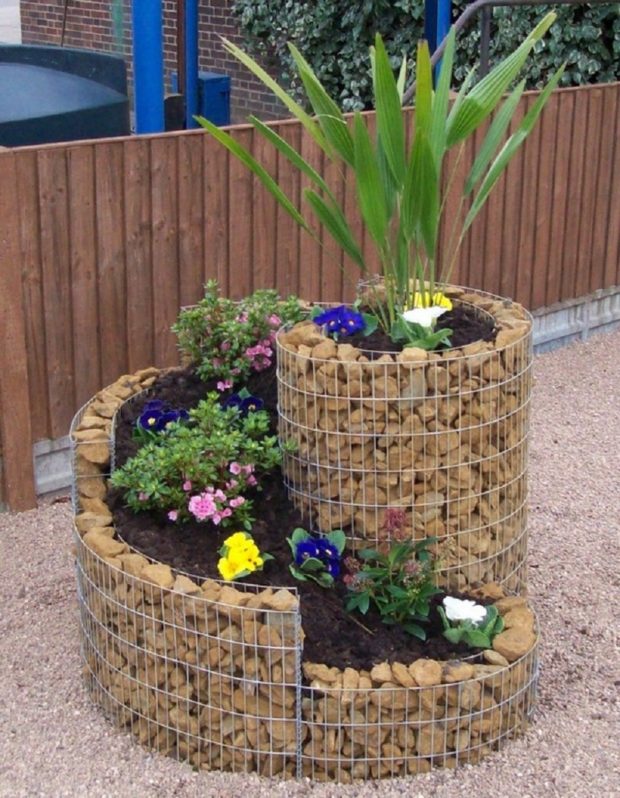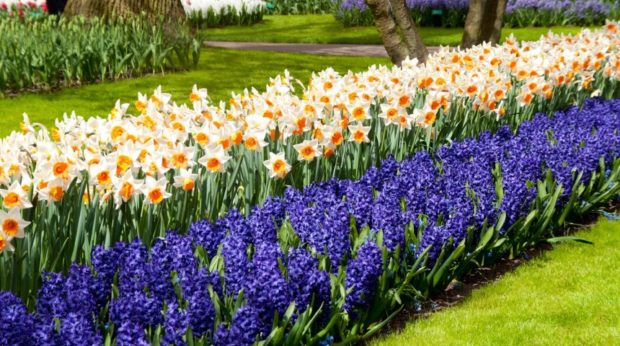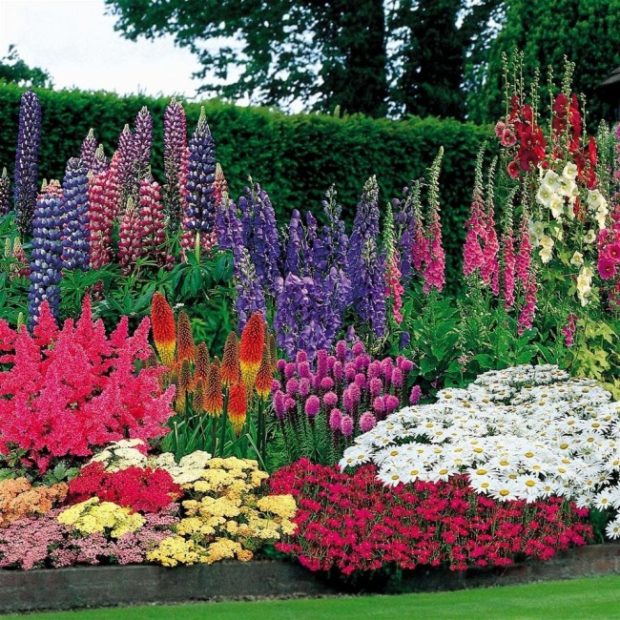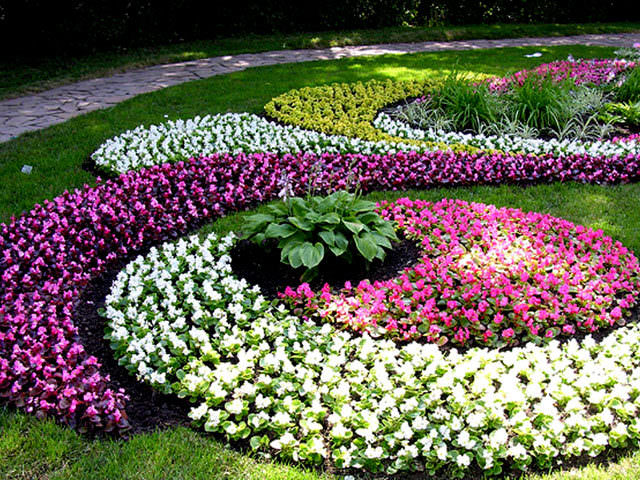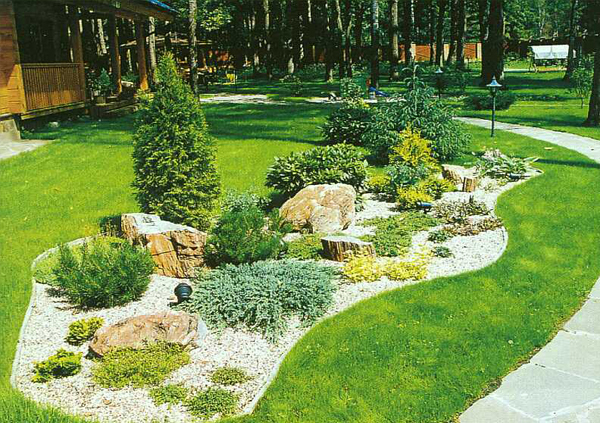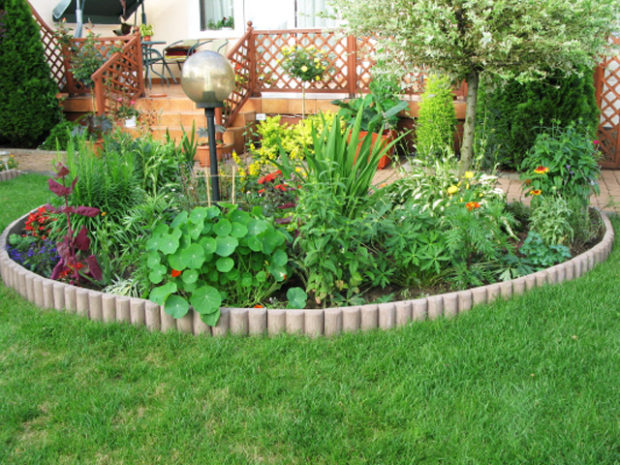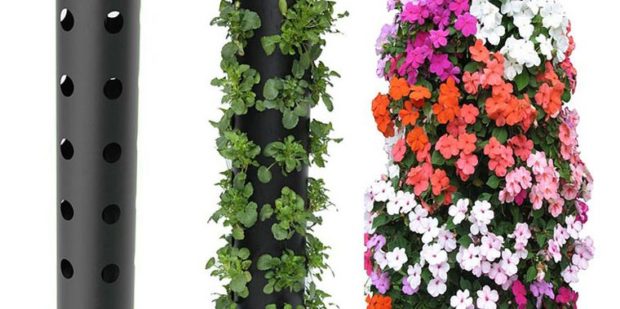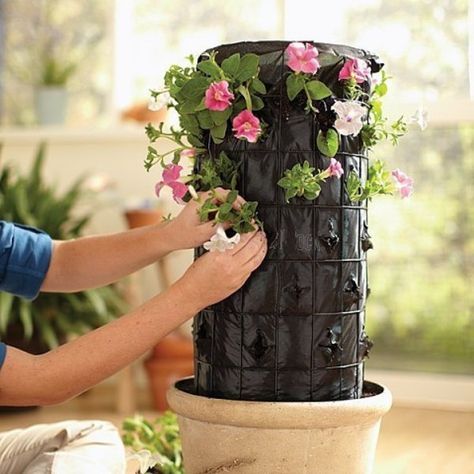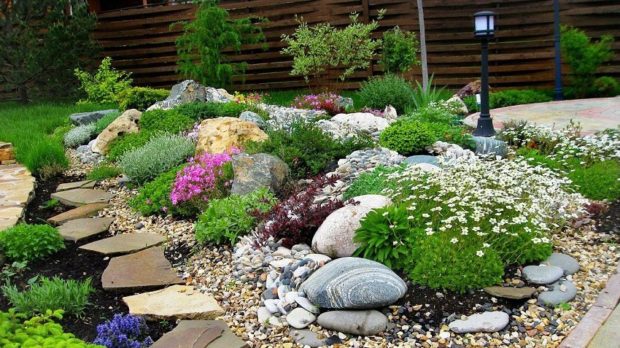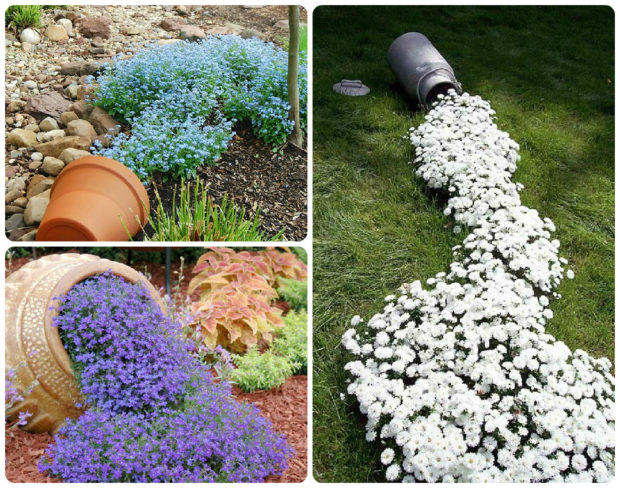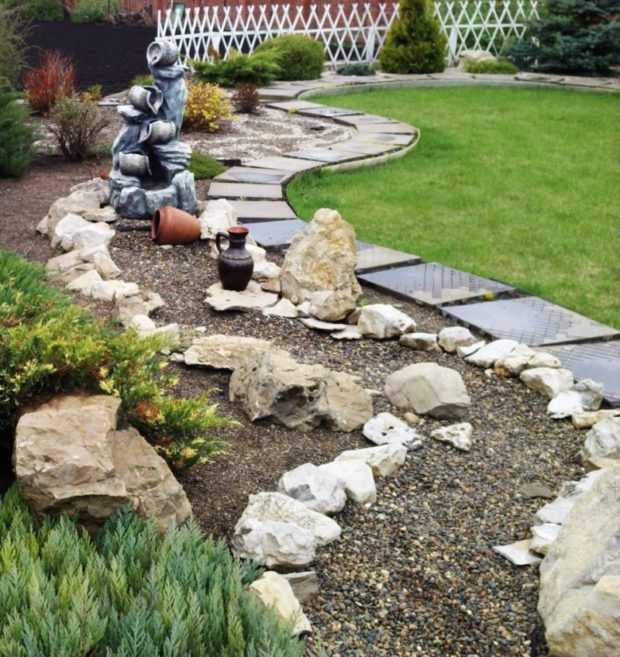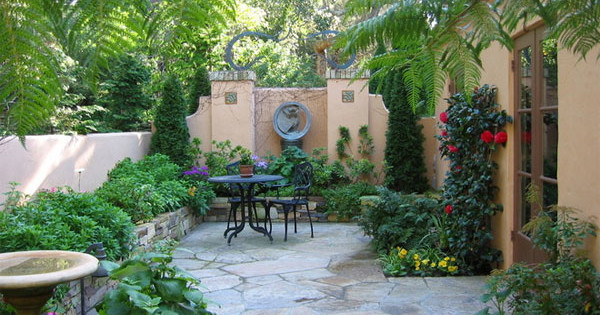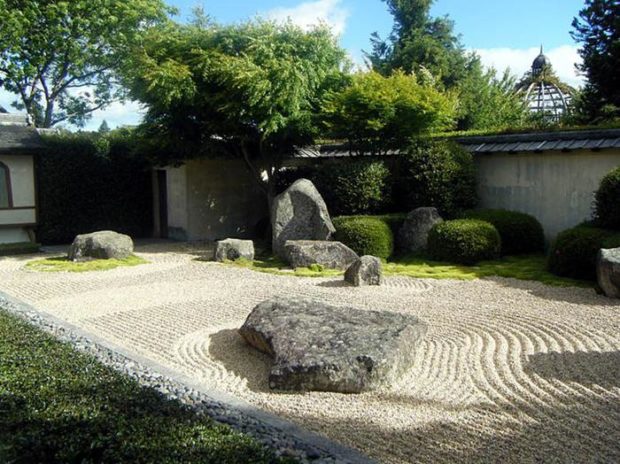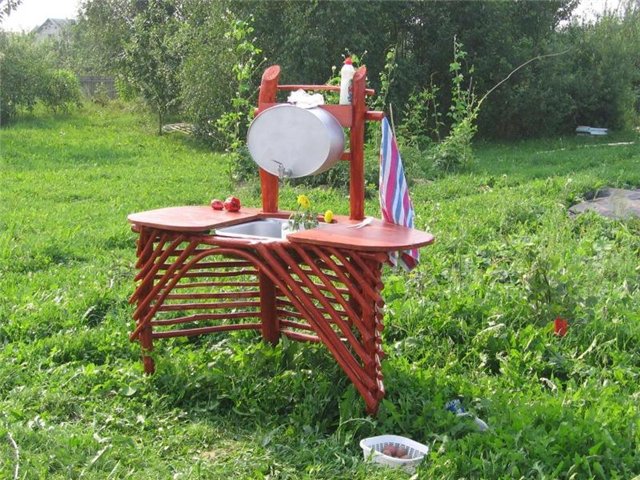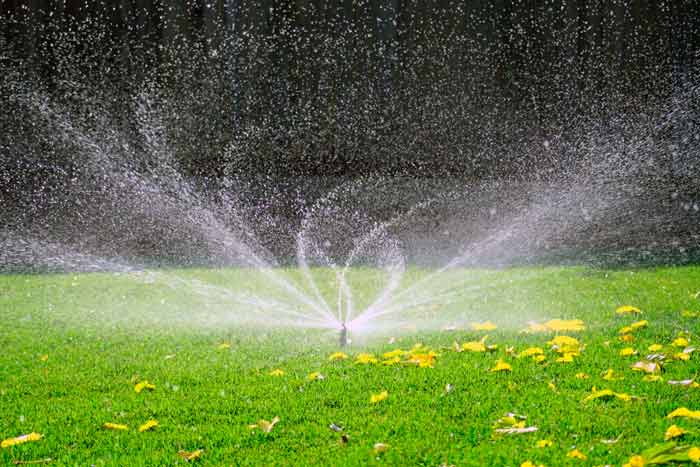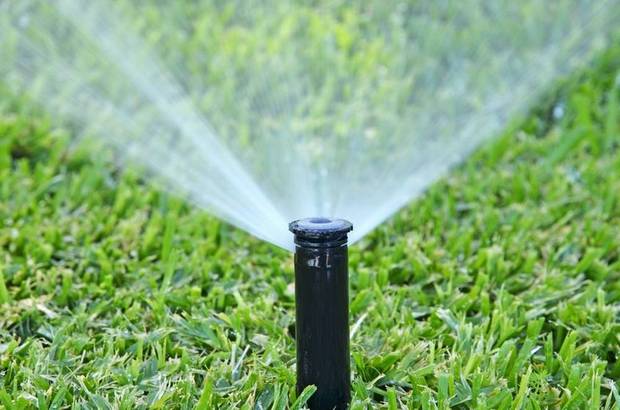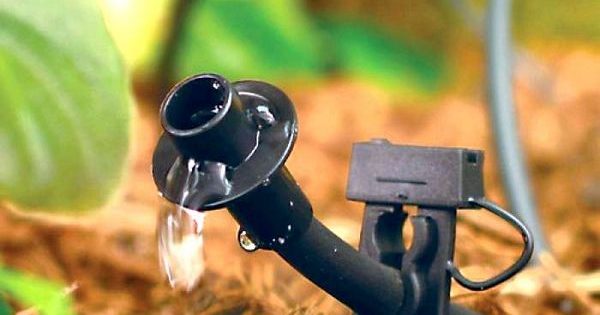How to make a flowerbed at the cottage with your own hands: 9 ideas, tips and photos
In whatever ways, folk craftsmen decorated their garden or summer cottage to make it unusual and colorful. Very often you can meet the well-known swans from old tires, diverse shapes from plastic bottles or CDs etc. But do not forget about the more natural and wonderful idea of decorating the site - decorative flower beds. You must admit that the beauty of natural flowers cannot be compared with anything else. In this article we will look at a few ways to make a flower bed in the country with your own hands without special expenses for the joy of relatives and the envy of neighbors. Please note that in this article there are no references and examples of organizing flower beds made of rubber tires or plastic bottles, which, to put it mildly, have become somewhat obsolete.
The choice of plants, places, forms of flower beds
Making a flowerbed yourself is not as easy as it might seem at first glance. Technically, of course, this will not cause difficulties - everyone will be able to dig the earth and make it favorable for plants using fertilizers. Much more difficult choose the right plant varieties that will get along with each other, and bloom with the desired sequence. Another important role is played by the location of the flowerbed. But the well-known character is not so terrible as they draw him. Moreover, when you create something with your own hands, you invest there a piece of your soul, patience and work. And in the end, it becomes a matter of pride not only for you personally, but also a subject for the admiration of everyone around. We will deal with all the main points of creating a flower bed in order.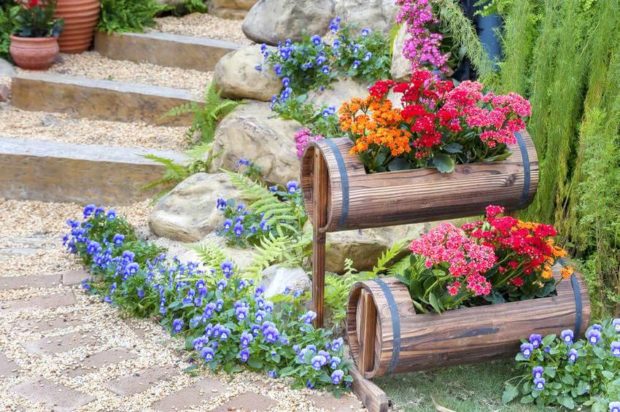
Location selection
This moment is very important to ensure favorable conditions for the growth and development of plants. Therefore, it is worth being guided not only by your preferences, but also by the following criteria:
- Remoteness from the water source. It is no secret that any plant needs a certain amount of moisture for active growth. That is why it is necessary to think over the water supply to the desired place in advance or vice versa - bring the flower bed closer to the existing access point;
- A sufficient amount of sunlight. Breaking a flowerbed around trees can hardly be called a lucky idea. Firstly, the root system of trees is much stronger than any root system of flowers or small bushes. Because of this, a large amount of moisture and nutrients will be delivered not to the flower garden, but to them. Secondly, very rare species of flowering plants feel good in constant shade. Therefore, the place for the flowerbed should be open and well-lit;
- The flowerbed primarily serves source of aesthetic pleasure from her contemplation. Therefore, it makes no sense to work on its creation somewhere in the backyard, where you are very rarely. Flower beds are usually located near verandasin front of the terrace or around pergolas. It is advisable to decorate in this way the main entrance to the house, for example, on both sides of porch or stairs. Narrow flowerbeds on both sides of the bed look very neat and harmonious garden paths. If your site has a small fountain or pond, be sure to supplement it with flowers. Undoubtedly, such an element already attracts great attention, but surrounded by flowering plants will look more natural and holistic.
So, conclusion - The place for the flower garden should be located near the source of water, be well-lit and accessible to your eyes.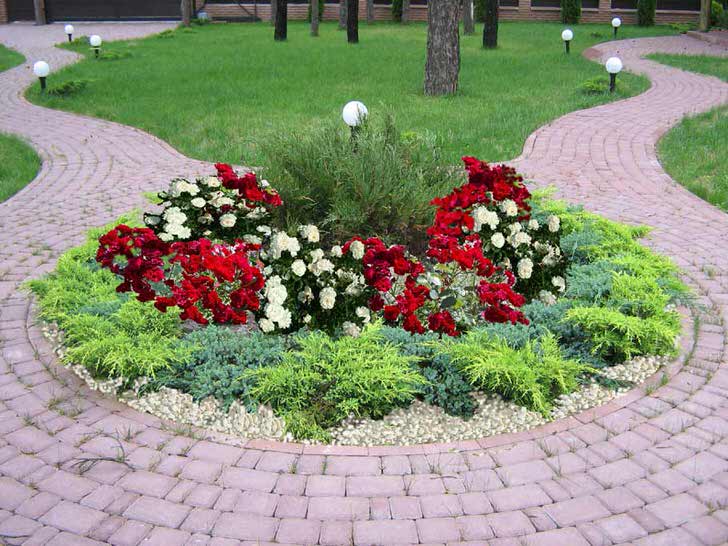
Choosing the shape and size of the flowerbed
It is difficult to select the optimal location of the flower garden without first deciding on its shape and size. Here are some helpful tips regarding this item:
- For some reason, everyone unanimously claims that the best form for a flower bed is the most simple geometric figure. That is, a circle, oval, square or rectangle. On the one hand, this is true regarding the simplicity of its organization. But on the other hand - after all, this is a real work of art, and the artist in this case is none other than yourself. If you feel that you can do it, and you have long dreamed of a flowerbed in the shape of a butterfly, a heart, and anything else, on your site, then when should you give free rein to your fantasies?
- But you should think carefully before giving preference non-standard flowerbed. If it is planned alone on the entire site, then it will really become its highlight. If there are several flower beds on the site, and all of them will be of different shapes, you will not be able to achieve unity of composition. In this case, it is really better to limit yourself to primitive figures. But nothing will distract from the beauty of the plants themselves.
- The size of the flower bed should be proportional to the size of the plot. If the flower garden will occupy a large part of it, then this may cause inconvenience of movement. And in the future, if you decide to install Garden swing go equip barbecue, for them there simply may not be a place. Do not break then what you worked so hard on. Too small flower beds look ridiculous, get lost on the general background and it seems that these flowers grew here randomly. Many seasoned landscape designers claim that it is better to break one larger, or several elements of medium size, than many small ones.
To easily follow the tips above, draw a plan of your site. Mark on it all the buildings, paths and size them. So it will be clearer and easier to understand which form will fit in the best way already available landscape, and which size would be preferable. In general, any work related to the site should begin with the development of a plan. This greatly speeds up the process.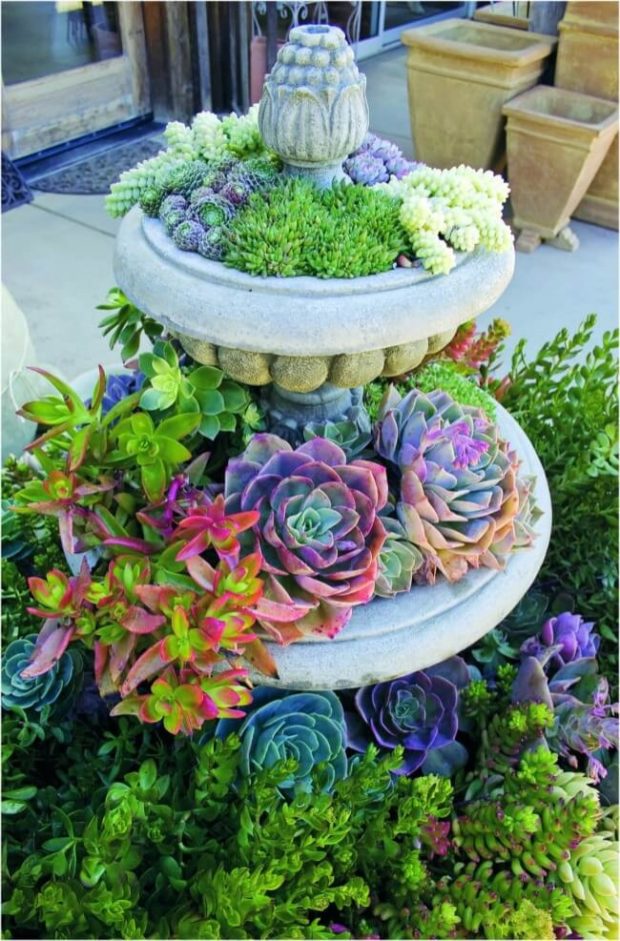
Selection of plant varieties and frequency of planting
So we come to one of the most important issues. How competently you combine plants in your flower garden will determine the duration of its flowering, its resistance to drought, the growth rate and height of the plantings.
- Choose plants that have similar rates of moisture consumption.
- Be sure to choose plants that require the same habitat. That is, strongly acidic or slightly acidified soil, loose or more dense. And the same amount of sunlight. Combining these indicators in one small area will be very difficult. Of course, if your flowerbed is not a set of multi-level flower pots.
- Neighboring plants should not harm each other.
- Depending on what effect you want to achieve, choose either the same or, conversely, plants with different heights. In the latter case, higher varieties are centered so that they do not obscure undersized ones.
- The color scheme of the flower beds can be monotonous or variegated and diverse. In order not to overdo it, do not include more than 4-6 shades.
- Also, plants can be annual or perennial. Annual plants can be planted in a certain order and each year to get a new look for their flower beds, forming various patterns. True, this requires a lot of work and considerable patience. But many housewives find the process of planting plants in the ground very calming and fascinating. Perennials require less maintenance, rarer additional replanting. They are best planted in random order, without adhering to a strict scheme. So your flowerbed will look more natural.
- Landing frequency one more important moment. It is much easier to plant already sprouted plants. So it is clearly visible where the gaps are, whether you have left enough space for further plant growth, whether the seedlings are evenly placed on the site. Much harder with seeds. All the time, it seems that they poured too little, that half will not sprout and get a “bald” and too rare flower bed. These fears are in vain. Even if the seedlings are rarer than you would like, it is better to plant plants than to rip out already formed sprouts. A dense landing will only complicate the development of sprouts and slow down their growth.

To select the desired color scheme and visualize how your future flower bed will look from the side, back to drawing up a landing pattern. Draw a plot on which you will plant the plants, adhering to the chosen shape and its size. Decide on the number of different colors. Divide the site into sectors or smaller individual sections and immediately paint with the appropriate color. Be sure to imagine which side you will most often admire the flower bed. Put in this direction an arrow directed at the flowerbed. This is your central point. The point on which to build your floral arrangement. You can arrange plants by color or height symmetrically relative to it. You can concentrate the tallest plants in the middle, and then go to a decline in height and, for example, to change flowers.
Experiment, make adjustments, and for this, a diagram is drawn up. Plus, if you draw a plot on a scale, you will be able to determine the size of each individual sector with different plants and calculate their required number. So the most crucial stage has ended - planning. Now you can roughly imagine the amount of work and the necessary materials. As you can see, nothing excessive in the process do-it-yourself flowerbeds not. And when you get to work, you won’t notice how you begin to enjoy it. Especially when your creation will sparkle with bright colors.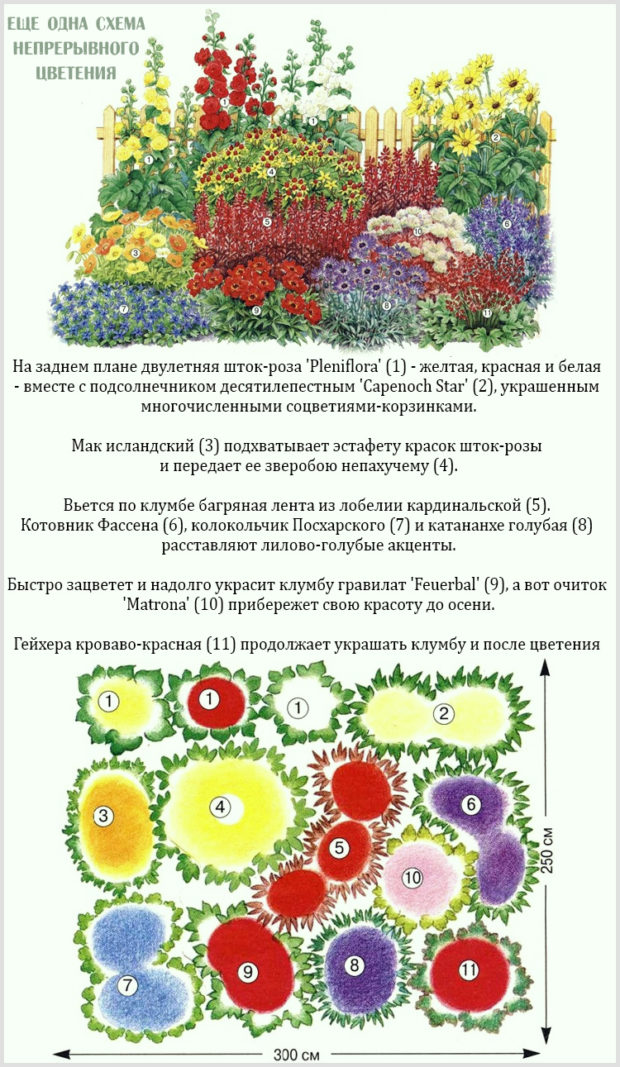 Do not forget to prepare and myself the soil to the landing. To do this, dig the top layer at a depth of at least 20 cm, clean the soil from weeds, roots and other debris, add the required amount of fertilizer, level and moisten well. Choose fertilizers according to the recommendations on the seed packaging. Allow the soil to settle down and settle for a week, and then proceed with further work.
Do not forget to prepare and myself the soil to the landing. To do this, dig the top layer at a depth of at least 20 cm, clean the soil from weeds, roots and other debris, add the required amount of fertilizer, level and moisten well. Choose fertilizers according to the recommendations on the seed packaging. Allow the soil to settle down and settle for a week, and then proceed with further work.
What are the flower beds?
Now let's talk about which varieties of flower beds are most often found on sites and which flower beds modern landscape designers prefer to create:
- Carpet bed - is a simple horizontal flowerbed on which stunted plants are planted. Often they have a high planting density, medium-sized flowers and leaves. It is very convenient to form various living patterns from such plants that resemble a chic Persian carpet. However, to achieve such a uniform and dense flowering often fails the first time. Especially if you deal with the flower garden irregularly. The shape of such a flower bed can be any, but it looks most advantageous with a fairly large size.

- Monoclumba - a flower garden of any shape, size and configuration in which one color scheme or one type of plant prevails. As they say - simply and tastefully!

- Horizontal flowerbed with plants of various heights and colors - the easiest to implement on your own. Especially if before that you never had anything to do with planting something in the ground. To simplify the task as much as possible, perennial flowering plants are selected. Despite its simplicity, such a flowerbed can impress with its appearance, if you approach the issue with imagination. For example, try to choose plants that will have a smooth transition from dark to lighter - gradient color. Or plant plants in a rainbow sequence.

- Vertical flower bed - Very often used to decorate vertical surfaces. For example, to create a hedge along the fence, to decorate the walls of the gazebo or the house itself, porch, arch or porch. Not only creates a cozy atmosphere but also serves as a source of additional coolness.

- Annular flowerbed - A very interesting way to decorate an existing decorative object on the site. Such living rings are most often framed by statues, small ponds or fountains, bushes or low trees.

- Flowerbed - it can frame garden paths, a playground, a recreation area, just extend along the entire perimeter of the site along the fence. Typically, such flower beds have a small width.

- Alpine hill - One of the most aesthetic of the possible types of flower beds. It is an artificially created hill, on which are located various sizes stones or bouldersbetween which medium-sized flowering or coniferous plants grow. For such a flower garden, it is worth choosing exclusively perennial plant varieties.

- Flowerbed flowerpot - resembles a very large flower pot. They are equipped when there is very little free space on the site and there is no way to break a full-fledged flowerbed. It is also very convenient for them to decorate the entrance to the house or the central gate. Also, flowerpots are successfully used to decorate terraces laid paving slabs or another type of coating where there is simply no land for plant growth.

- Rabatka - a flower bed for real perfectionists. Its main rule is absolute geometric clarity. Such a flower garden can have only a long rectangular shape, and all plants must have exactly the same height. But the colors can be used in a variety of ways. Such a flower bed always looks very well-groomed, laconic and completed. Very often, a discount is organized along the tracks or around the perimeter of the site.

- Mixborder - A find for true lovers of absolutely all kinds of flowers, who can not choose a particular variety. Plants are selected absolutely different in height, color and flowering season. Thus, such a flowerbed can please you almost all year round.

- Arabesque, or ground floor - One of the most thoughtful and sketchy flower beds. The plants on it are arranged in a strict order and form various symbols and patterns. Its organization requires a thorough approach and patience.

- Rockery - Bribes many with its originality. A similar flowerbed is a mix of stones, various low shrubs, low flowering plants, ornamental cereal and grassy varieties. Plants are planted between stones of various shapes and sizes, however, unlike an alpine hill, rockery is a flat surface.

Simple materials for fencing flower beds
The flower bed differs from the flower garden in that it has a clearly defined shape and a limitation in the form border. This not only allows you to give her a more well-groomed and orderly external view, but also protect the edges of the flowerbed from erosion, involuntary trampling and limit the area of distribution of plants.Often, improvised materials are used for borders, which can always be found on any site or bought for a nominal price:
- Can arrange plant borderbut a certain sort. They not only reliably preserve the clear contours of the flowerbed and prevent their distortion, but they themselves will maintain a strict shape. For these purposes, choose low, not more than 30-50 cm tall plants. Their attractive appearance should be maintained throughout the season. Most often used are annuals - marigolds, ageratum, petunia, sylvia, begonia. For flower beds flooded with sunlight, such varieties of perennial plants as rocky allisum, shrub aster, variegated cloves, bell, daisy, and horned violet are suitable. For more shady areas, it is recommended to plant geranium, primrose, hosta, fragile vesicle, large-leafed brunner;
- A more traditional way of bordering a flower bed is to use wild stone, which is laid out around the perimeter in one or two thicknesses;
- Bricksthat dig into the soil along the contour at an angle to form a neat toothed border;
- Small wood blocks can also be dug into the soil, previously treated with special moisture protection solutions;
- You can pour a layer river pebbles, wood bark, decorative multi-colored stones.

The main thing is that the borders on all the beds should be made of one material. If a real stone is selected, then it must be of the same breed. Perhaps your house or fence has a foundation of rubble stone. Then it makes sense to use it to design flower beds, and the appearance of your site will be harmonious.
Idea number 1. Vertical flower bed from improvised items
The advantage of vertical flower beds is their compactness. They will be a wonderful decoration for a modest sized plot. Making a vertical flowerbed is very simple using the simplest materials. The most suitable varieties of plants will be lush flowers, behind the foliage and flowers of which it is easy to hide the design itself. Very often, for vertical flower beds, petunia is chosen. Consider the option of making the base for a bed of wide pvc pipethat could remain with you after the repair:
- To begin with, decide whether your flowerbed will be dug directly into the ground, or will it be portable, that is, stand in a large floor pot;
- If you have chosen the second option, then select a container in advance. It can be an old aluminum or plastic bucket that can be wrapped with twine, painted, pasted with self-adhesive paper or a beautiful cloth. Old waste pan, plastic canister, etc. The main thing is to beautifully design the selected item, as it will be in sight;
- Now it's time to prepare the pipe itself. A variety of large diameter, which is usually used to replace the central one, is suitable for us. sewer drain. If there is a pipe of even larger diameter, it will be even more convenient to work, and the design will come out more stable;
- In the wall of the pipe along the entire length in a circle, you need to cut holes. You can cut circles or squares as you wish. Their size should be such that you can put a seedling there. A circle with a diameter of up to 5 cm is enough. Cutting a pipe is difficult enough, therefore it is better to entrust this matter to the strong half of humanity, after having previously made the markup;
- Now you need to install the pipe with holes in the pot or bucket, pour around the soil and compact it well. For these purposes, you can use ordinary land without special fertilizers. You can pour sand or fine gravel, the main thing is that the pipe does not stagger;
- Now you need to fill the fertile soil into the inner cavity of the pipe. This must be done gradually. Pour a layer of earth up to 30 cm high, water it, wait until it settles. Thus, it is necessary to fill the entire pipe to the very top;
- Let the earth settle down a little, check the reliability and stability of your structure, and then proceed to planting seedlings;
- Please note that the recesses for seedlings must be made at an angle of approximately 45 degrees to the surface of the pipe, and not just horizontally. So you will achieve longer channels and less likely to touch adjacent roots;
- By the way, if the flower bed is still portable, then it is better to immediately install it in the desired place, otherwise then it may be too heavy.

Now it remains only to wait until the plants grow up and hide our pipe with their greenery. The only thing that can cause inconvenience is watering such a flower bed. If you pour water through the top, it is unlikely to reach the lowest plants, especially if the height of the flowerbed is about 1 meter. Therefore, it is better to carefully water each bush with a watering can through the very hole in which it is planted.
One more simple way the manufacture of a vertical flower bed - the conclusion of the soil in a metal mesh:
- By a similar principle, prepare the base container;
From the remainder mesh netting or another mesh of non-thick metal wire form a cylinder; - Previously, thick polyethylene is fixed on the grid with the help of a stapler, which will play the role of the walls, and will not allow the earth to wake up through the grid;
- Now you need help. One person should place the cylinder from the grid in the center of the pot, and the other, first fill the fertile soil inward, and then sand, gravel or ordinary earth around the pipe. If you act the other way around, you can deform the grid;
- Now it remains to make holes in the polyethylene in the right place and plant the seedlings.

The height of such structures should not exceed 60-70 cm, otherwise the grid may simply not withstand the load and bend. But you can create a composition of several vertical flower beds of different sizes. And if you have enough patience, then form small columns in this way, for example, around a gazebo or other object.
Idea number 2. DIY Alpine slide
It’s quite difficult to make an alpine slide with your own hands. You need to create a small hill, which over time will not settle, and will retain its shape. But the rock garden even of a small size always looks very natural and attractive. Let's consider step by step:
- In order for the slide to be strong, it is necessary to take care of reliable foundation. To do this, dig a hole with a depth of 70-80 cm, depending on the desired height. Accordingly, the higher you want to make the embankment, the deeper the pit should be, but not more than 1 meter;
- At the bottom you need to do drainage pillow from gravel, broken brick or other construction waste. Pour water generously and tamp. There is a very important point here - in the center of the pit, the drainage should be higher;
- A layer is poured over the broken stone river sand, about 10 cm tall, and then covered with clay soil. Clay can be purchased separately and mixed with the ground. So you fasten it and make it denser. Clay soils absorb less water and are less loose in structure;
- If at the formation stage you neglect one of the above layers, then in the future your slide can “slide” after the first heavy rainfall;
- Now you need to lay on top of the earthen mound stones of different sizes. Do not do everything too orderly. Smaller stones can be installed on large. Start laying from top to bottom. At the top, place smaller stones. It should create the effect that these stones appeared here in a natural way. When placing stones, leave space between them - pockets. It is in them that fertile soil is poured, and plants are planted;
- When you finish working with stones, water the slide with water. In places where the soil strongly settles, it is necessary to add the missing amount;
- Alpine slide plants are best chosen perennial, different seasonality. Then, for almost the entire season, she will be able to delight you with a flowering view. At the top you can plant a small tree or ornamental shrubs - thawed, juniper, dwarf pine. Flowering plants should not be too tall so as not to obscure the stones. Suitable violets, poppies, cacti, edelweiss, spirea, cinquefoil. In addition, these species coexist perfectly with each other;
- Little secret - If you add a little fine crumb to the soil for planting, it will retain moisture longer and will be less prone to weed germination.

So, with no less effort, you will get a wonderful flowerbed that will delight you for many seasons.
Idea number 3. DIY flower beds
Who said that a flowerbed must be on the ground? And what about the idea of a hanging flowerbed? And this is not about the usual flowerpots with petunias that adorn almost every gazebo in the country. Just imagine a beautiful stand made of metal or wood, on which old bird cages. And now beautiful flowers are blooming in them.
- In order not to splurge on expensive forged stands, you can use, for example, a small tree that has dried up. Or a tree that has become emergency and is subject to cut. Remove the bark, strip the trunk, open with varnish or color.
- Dig a hole in the place where the flower bed will be located, pour on the bottom of gravel and sand, fill it with water, install a tree and fill it with soil. Tamp the ground well and water it several times, filling up the soil;
- Now it's time to transform the old cells. Use spray paint to speed up your work. Color the rods in the selected color. After complete drying, cover the bottom of the cell with polyethylene, which should go on the sides;
- Put soil and plant plants. Various succulents and climbing plants look very healthy. Since it will not be possible to fill a lot of soil, choose plants with a shallow root system.

The advantage of such a flowerbed is that in the season of severe frosts, the cells can be easily removed and brought into the house, thereby protecting the plants. Well, and, of course, the unusual appearance of such a flowerbed certainly will not go unnoticed.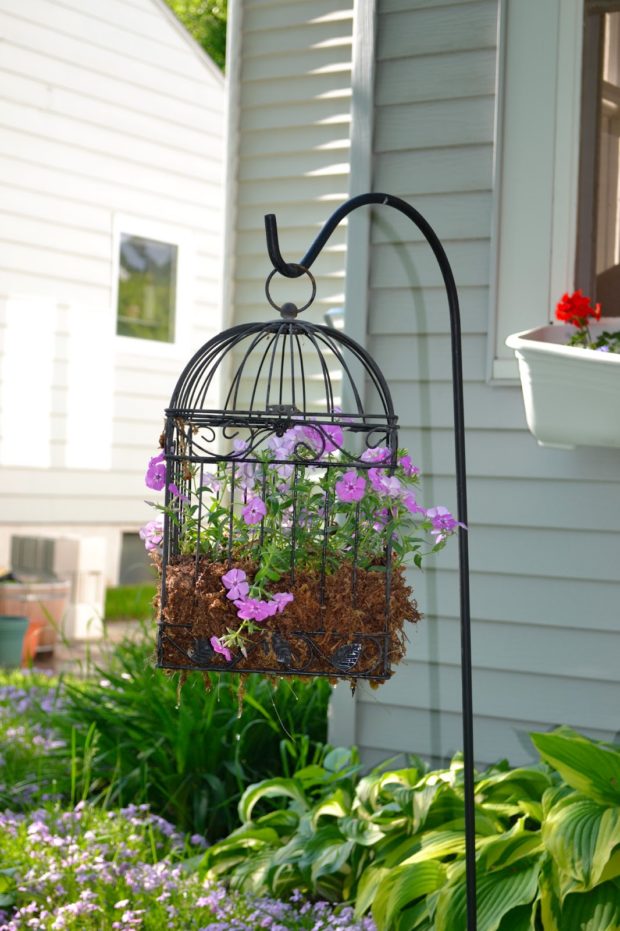
Idea number 4. DIY flowing flowerbed
This type of flowerbed is very simple to do with your own hands. It is notable for its simplicity of organization and stunning appearance, which has not yet had time to become boring. The idea is to create the illusion that a liquid flows out of a vessel toppled to the ground, in the role of which flowers will act.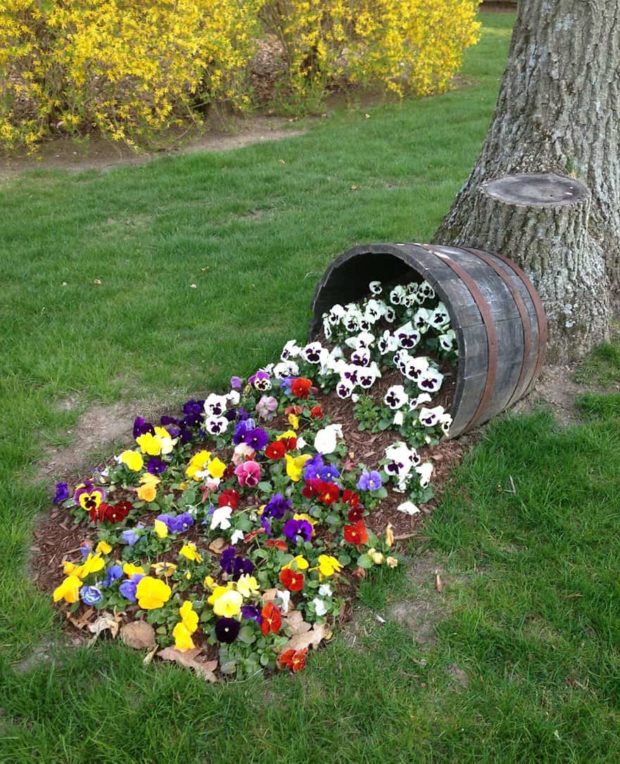 In order to make a flowerbed-trickle we need:
In order to make a flowerbed-trickle we need:
- First do markup. It is better to choose smooth wave-like forms for the future brook. Dig up the topsoil and clear it of debris;
- Now you need to find an unnecessary clay or ceramic jug, an old beautiful vase, watering can or other suitable container and dig it in an inclined position at the beginning of the brook. It is very important to choose a vessel with a wide throat, since it will need to be poured into the soil and planted;
- Well, now it's up to the small - plant your favorite flowers according to the layout and enjoy an unusual flowerbed.

Idea number 5. Original stone flowerbed
Stone beds always look aesthetically pleasing and neat. The combination of stone with plants is never boring. We suggest using different types of stones to form unusual designs. Whatever idea comes to your mind, the main thing to stick to is Highlights:
- Better to use harder rocksfor example granite. They will no longer be exposed to adverse environmental factors. A softer material, such as a shell rock, may eventually become covered with delicate moss, which will make its appearance even more attractive;
- Any stone structure requires at least simple foundation. It is necessary to remove the top layer of the earth, pour a layer of gravel and sand, tamp and only begin to lay out the field to lay stones on solution;
- When laying stone, try to apply the mortar so that it does not crawl out through the seams. This will ruin the appearance of the flowerbed;
- After the solution has completely dried, fill the seams with a transparent sealant. This will prevent cracking of the adhesive mixture;
- If the height of the stone sides is supposed to be low, then you can simply dig a trench of sufficient depth, fill it with crushed stone, and lay the stones on top. This will create the illusion that the stones "grow" directly from the ground.

Idea number 6. Flowerbed of sawn logs or old stump
Usually all the unnecessary are taken to the country. Such things that managed to get sprayed in the garage, but the hand did not rise to throw them away, and now they are in the summer cottage. On the Internet, we found many examples of simply stunning reincarnation of the most common things. Perhaps one of them will appeal to you.
On any site there is an old log or stump from a once-felled tree. It is almost impossible to see an old stump without an internal feeling of irritation. So it needs to be revived! To do this, remove the inside of it with a saw, chisel or other tool convenient for you. After this, it is necessary to cover the formed cavity with polyethylene, fill it with soil and plant flowers in an improvised flowerpot. Now this is not just an old rotten stump, but an element of landscape design.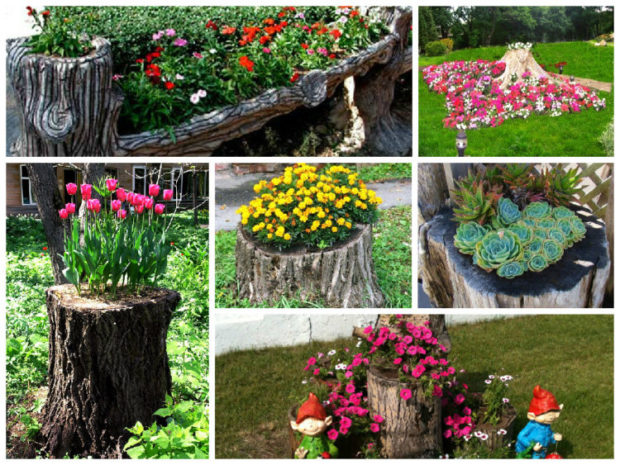
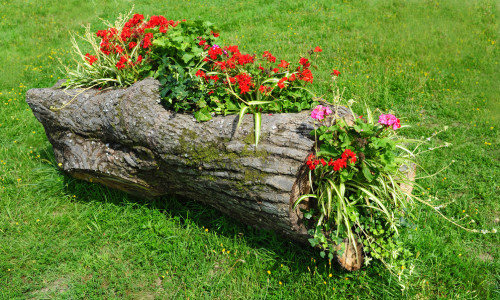
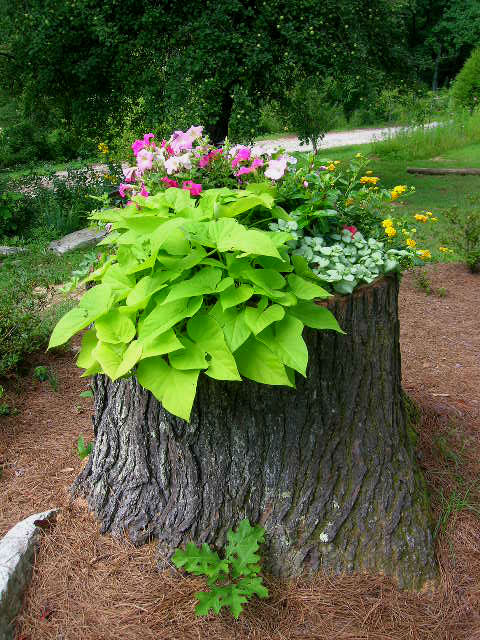

Idea number 7. Original use of an old bathtub
Besides the fact that the inner surface old bath you can paint it blue, dig it into the ground and make a mini-pond out of it, you can use it as a very large flowerpot. Just install it in a suitable place, decorate the outer surface and ennoble with plants. It is possible to build a wooden formwork for such a flowerbed, if there are no beautiful carved legs.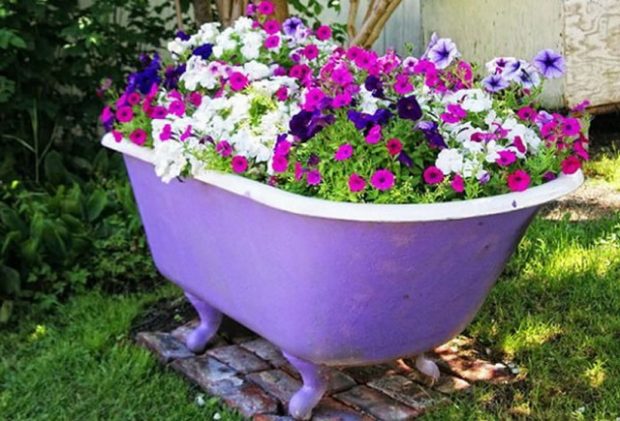
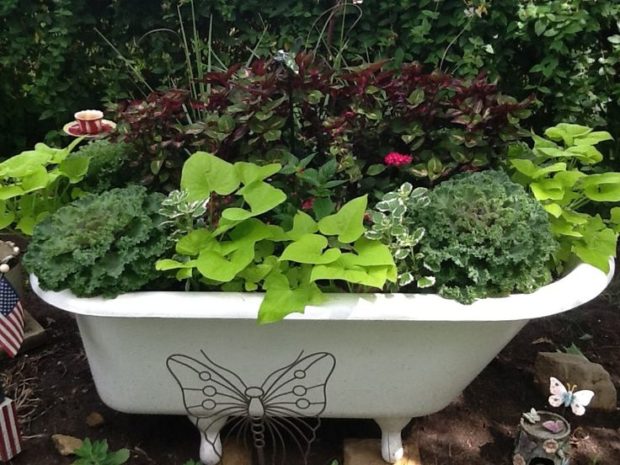
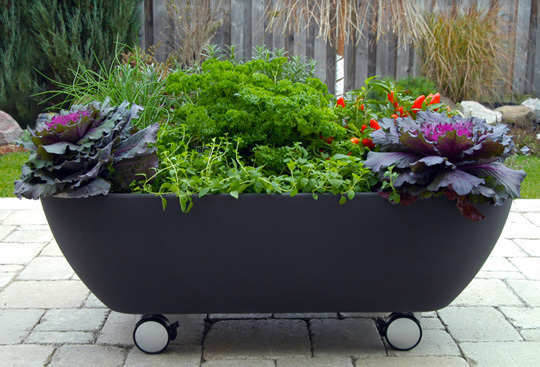
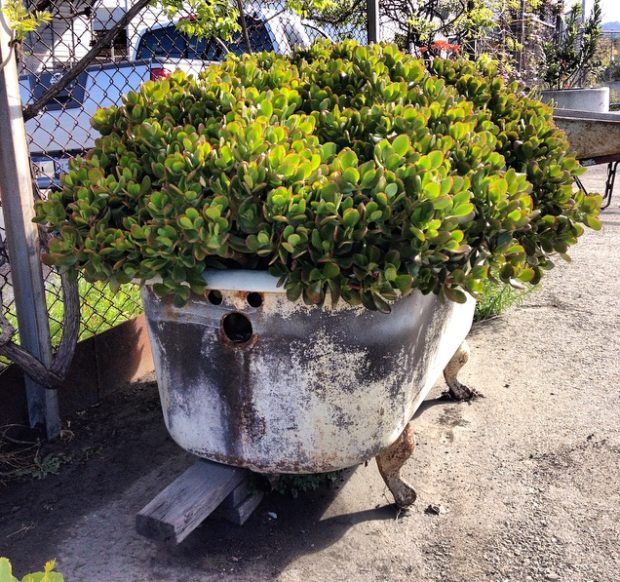
Idea number 8. Unusual flower bed made of old furniture
You can float and old furniture. Chairs, dressers, just boxes from the old sideboard - everything that lies badly and can accommodate at least a small amount of land. Sand the wooden elements, open with varnish or paint, set in a suitable place and start planting. To do this, all surfaces should be covered with a film. Be sure to handle the wood well and let it dry well. Similar elements look good in a duet. For example, a chest of drawers in combination with several chairs or just a pair of chairs. Such flower beds are well suited for decorating a plot with a house in a rustic style or in Provence style.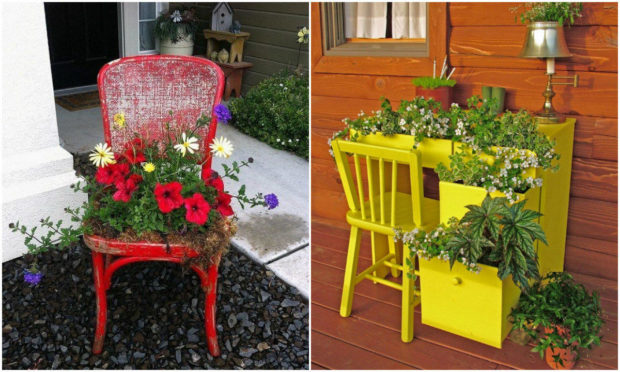
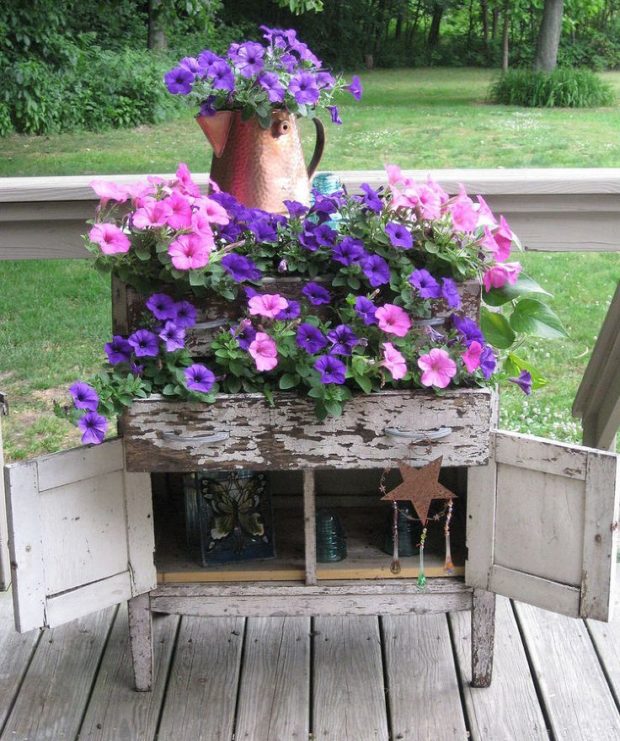
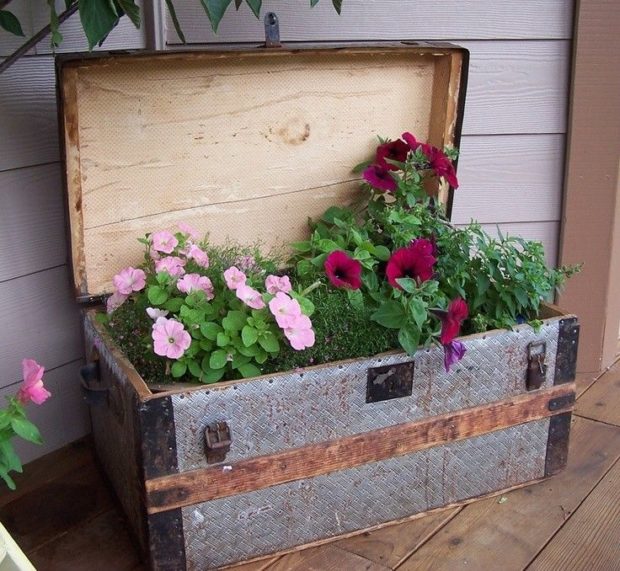
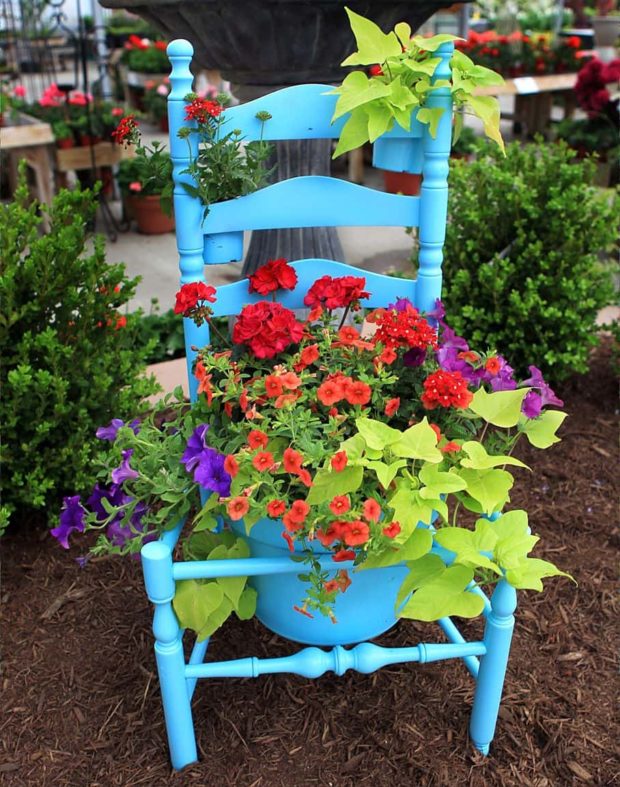
Idea number 9. Ennoble a rusty boat or old bike
In the same way as with the old bathroom, you can do with an old rusty boat or a broken bike. Strip off areas affected by rust. Paint in your favorite color. Set at an interesting angle, elbows on large stones. Add a flower box to the bicycle seat. Hang a couple of pots on the steering wheel. Fill the boat with earth, plant small shrubs, sprinkle nearby sea pebbles and the unusual composition is ready! Having shown imagination, you can make mini-beds of the most unexpected things. The main thing is that you like it.